Category: Tips for gifts, visits
Posted by Dr. El - July 19, 2018 - Depression/Mental illness/Substance Abuse, For Fun, For Recreation Staff, McKnight's Long-Term Care News, Resident care, Stress/Crisis management, Tips for gifts, visits
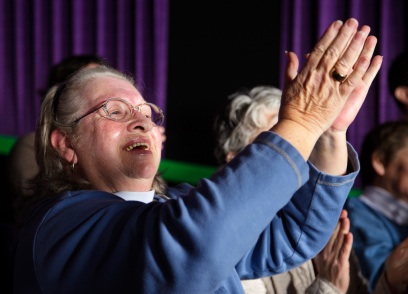
Here’s my latest article on McKnight’s Long-Term Care News:

“Scream as loud as you can,” I encouraged my companions before we plunged down the waterslide in our rubber raft at the water park on Independence Day. “There aren’t enough opportunities for yelling in everyday life. Let’s make the most of it while it’s socially acceptable.” The shouts of our foursome pierced the air as we flew down the steep slopes and then dissolved into laughter as we splashed to a halt at the bottom of the ride. “That was great!” we all agreed.
Our residents tend to be stressed out. At a minimum, they’ve suffered debilitating and often sudden physical losses, they’re living 24/7 in a communal environment and they have to rely for assistance on helpers they’re sharing with other people. Add to this unfamiliar food, financial stressors, physical separation from their homes and family and worries about the future.
Is there any one of us who wouldn’t be angry about something in that situation? Yet we as organizations strive to have units filled with residents without “behaviors.”
I’m not suggesting nightly “primal scream” sessions, but we could add into the rotation some activities where residents get to be “bad,” or at least aren’t expected to be so darn good all the time.
For example, I used to counsel a 100-year old woman, Claire, whose active life had slowed to a crawl due to age, arthritis and other maladies. She often let out her frustrations by making sarcastic comments to her aides and other residents, which led to conflicts.
To help her blow off steam, as we talked, we slowly set up dominoes in a circuitous row on a table. When the domino chain was completed, I’d give her the signal and she’d gently push the first domino over with one arthritic finger and watch with glee as the whole chain loudly self-destructed. On some days, Claire was particularly “bad” and didn’t wait for the signal. This activity allowed her to be “good” bad and her sarcasm diminished.
For the entire article, visit:
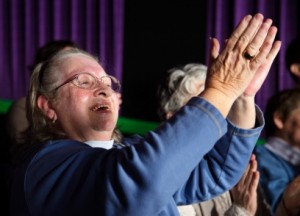
Posted by Dr. El - February 15, 2018 - Business Strategies, Customer service, Inspiration, McKnight's Long-Term Care News, Resident care, Tips for gifts, visits

Here’s my latest article on McKnight’s Long-Term Care News:

Last week, I attended an accessible design symposium at the Cooper Hewitt Museum in New York City to see what ideas I could use with elders in long-term care. Through listening to the symposium speakers, reading descriptions of works featured in the student design contest and viewing the Access+Ability exhibit, I found more than I had expected.
Crash course in accessible design
I suspect I’m not the only McKnight’s reader with a lack of knowledge about accessible design — even though we work with elders with abilities that are typically different than those of younger adults.
Patricia Moore, introduced as “the mother of universal design,” told the audience that her elderly grandparents inspired her work. They struggled to maintain their independence in a world that made it difficult for them. “Grandma wasn’t broken,” she said. “The tools we gave her were inadequate.”
In my crash course in accessibility, I learned that objects can be designed in ways that increase the mismatch between our bodies and the environment or, in accessible design, to intentionally decrease that mismatch. For example, the standard design of a walking cane allows it to fall to the floor, making it difficult to retrieve for someone with mobility problems. In the Cooper Hewitt exhibit, I saw canes that stayed upright when not in use.
Another speaker discussed how “designing for disability” very often results in products that are good for everyone, such as books on tape, height adjustable desks or ramps for building access that are used by parents pushing strollers and travelers with rolling suitcases, in addition to those with walkers or wheelchairs.
Nothing about us without us
There was a small, vocal group of disability activists present. When I entered the symposium I was handed a card from their organization that read, “Nothing about us … without us.” They echoed the sentiment of the speakers that increasing the diversity of people designing products and systems results in products and systems that work better for a larger number of people.
Including elders and direct care staff in more of the decisions that affect them within our organizations is likely to result in better decisions.
For the entire article, visit:

Jeweled Hearing Aids

Posted by Dr. El - December 22, 2016 - Business Strategies, Communication, Customer service, Engaging with families, McKnight's Long-Term Care News, Tips for gifts, visits

Here’s my latest article on McKnight’s Long-Term Care News:

In his Dec. 6 McKnight’s Senior Living column, Editorial Director John O’Connor reported on a senior living center in Jiangsu province in China that offers cash rewards to people who visit their loved ones. Ten visits in a two-month period led to the equivalent of about $10; thirty visits brought about $29.
The result? The number of residents receiving regular visitors jumped from 10% to about half, no doubt making a huge impact on the lives of the residents and on the culture of the facility.
While this “positive reinforcement” obviously can be very valuable — and I agree with O’Connor’s alternatives to cash such as gift cards or entry into a raffle for a local restaurant — there’s a lot we can do to make family visits inherently more rewarding.
When long-term care providers accept the role of teachers, we can add great value to our services and enhance the experiences of the families who come to us for assistance.
The reality is that many relatives have no idea how to best engage with their loved one in long-term care.
Visitors often ask questions in ways that lead to frustration or embarrassment rather than the heart-to-heart they’re seeking. A television blaring in the background can make it difficult to maintain a conversation. Family members trying to do the right thing by visiting are met with disappointment and frustration rather than joyful connection. When visits don’t go as hoped, it can create what feels like punishment instead of reward.
Take a moment to listen to the comments of the visitors on the way out the door this holiday season. Look at their expressions. Do people seem satisfied with their visits or can more be done to create a pleasant experience? Astute administrators and nursing directors might overhear remarks such as, “Dad didn’t hear a thing I was saying,” or, “She couldn’t remember anything. I didn’t know what to say to her.”
Family visits can be vastly improved with some basic tools and education. Here are some ideas for this year and next:
For the entire article, visit:

Posted by Dr. El - August 2, 2016 - Customer service, For Fun, Inspiration, McKnight's Long-Term Care News, Resident care, Technology, Tips for gifts, visits

Here’s my latest article on McKnight’s Long-Term Care News:

![]()
My mother has a knack for taking something awkward and, as she puts it, “turning it into a feature.”
For example, the previous owners of our family home placed the living room couch in front of a protruding radiator so that the sofa was oddly and obviously a foot away from the wall. By contrast, my mother had shelves installed above the radiator so that it became a pleasant focal point for books, photos and the stereo system.
I follow this line of thought with regard to the need for assistive devices such as canes, walkers, and eyeglasses. It’s possible to convert something unappealing yet necessary into an item that bestows confidence, evinces a sense of humor or becomes more useful.
Turning assistive devices into a feature creates a psychological shift for the wearer. It gives residents an element of control over mostly uncontrollable circumstances and allows them to retain their personal style in a situation that tends to strip them of their uniqueness despite our best efforts.
An organization providing the opportunity to purchase or design desirable devices can generate a change in their culture. Seeing residents sporting colorful walkers or personalized wheelchairs rather than standard equipment sends a message of individualized care and a zest for life despite disability.
In the spirit of giving your residents an emotional boost and taking the sting out of the need for assistive devices, your organization might try some of the following ideas (found through my handy search engine):
• Residents can purchase sophisticated walking canes featuring fancy handles or colorful shafts with a wide selection of items under $50. I know many residents who would find that an excellent use of their Personal Needs Allowance (PNA).
• Another company features a colorful range of walking canes for about $40 each. Choices include floral motifs, Irish themes, US military and biker inspired designs.
• With PNA funds being as limited as they are, a decorating event is a great addition to the recreation calendar. Help residents embellish canes or create personalized walker or wheelchair bags to carry their belongings using colorful duct tape, Velcro and other supplies, or sew a handy cup holder.
For the entire article, visit:

Posted by Dr. El - July 21, 2016 - Resident care, Technology, Tips for gifts, visits

In Fashion’s Newest Frontier: The Disabled and the Displaced, author Vanessa Friedman writes about clothing for people with disabilities, referred to as “healthwear.”
Among the items now available are Magnaready‘s clothes with magnetic closures rather than difficult-to-manage buttons, and shirts by Care + Wear designed for people with medical ports so that they can stay comfortably dressed and merely unzip the section needed to access the port. Care + Wear also offers PICC line covers that come in a variety of fashionable colors.
Hallelujah! It’s about time! I can’t wait to see what’s next.

Care + Wear’s PICC line cover
Posted by Dr. El - November 20, 2015 - Communication, Engaging with families, For Families, Tips for gifts, visits, Videos

With the start of the holiday season, it’s time for this perennial post from Dr. El:

‘Twas the Week Before Christmas…
And 83-year old Albertha assured me her family was planning to take her home for the holidays.
“Have you talked to them about it? Have they called the social worker to arrange a pass, and meds, and transportation?”
“No,” she replied, “but they’re coming to get me.”
‘Twas the week after Christmas, and Albertha was glum.
“They didn’t show up. I waited all day, but they didn’t come.”
Albertha spent Christmas day watching other people go out on pass and return, and seeing families arriving with food and gifts and smiles.
Now my residents and I start discussing the holidays a few weeks in advance, addressing wishes and practicalities, phoning families if needed, and getting the social worker involved. We set up a hierarchy of plans.
Plan A: Go home for the day.
Plan B: Go out to a wheelchair accessible restaurant with family.
Plan C: Have visitors come with food and go around the corner for coffee, if possible, just to get out.
Plan D: Stay in with visitors and food.
Plan E: Talk to family members on the telephone, discussing plans for a future visit, while sitting in a room festooned with cards and holiday decorations. Attend the nursing home holiday party.
Plan F: Have a small holiday gathering in the room with nursing home friends after the facility party.
Since then, my people know what to expect from the holidays, even if the expectation is that their family might not arrive as hoped.
Three tips from Dr. El for the holidays (click here or view below): http://youtu.be/8HTjVoKQmKo
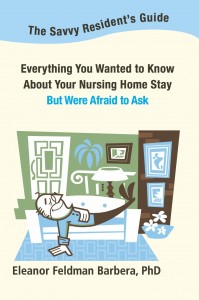
MyBetterNursingHome.com
Posted by Dr. El - December 17, 2014 - Customer service, Engaging with families, For Families, Tips for gifts, visits
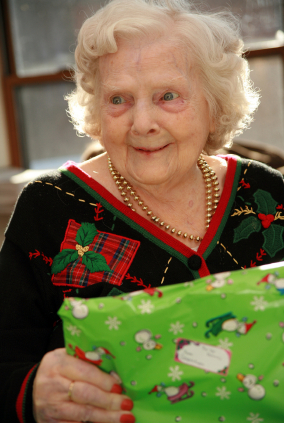
This post, along with my Planning for the Holidays article, could be printed out and left for family members in a prominent location. Think of it as your gift to every nursing home family.
~Happy Holidays from Dr. El at MyBetterNursingHome.com
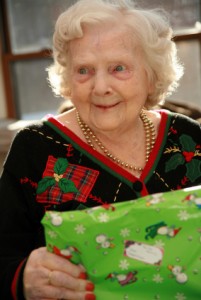
With the holiday season upon us, you may be wondering what would make a good present for a relative in a nursing home. In my efforts to banish the barren nursing home room, photos are still my number one pick for holiday gifts, but here are other suggestions (be sure to label everything!):
Nice lotions, soaps, and grooming products
A special bedspread
A “lap” blanket to wear while sitting in a wheelchair
Wheelchair accessories (Google it) like cup holders, side pockets, wheel lights, etc.
Sturdy clothes that can handle being washed in an industrial washing machine
Colorful bangle bracelets to blend in with nursing home wrist bands
My book, The Savvy Resident’s Guide: Everything You Wanted to Know About Your Nursing Home Stay But Were Afraid to Ask
Plants, or potted flowers, especially if you can come by to water them regularly
Great gifts from the heart:
Make a commitment to visit once a week, or once a month
Make a commitment to call once a week, or once a day
Organize friends and family so that each person has a week to call or visit
Bring a home-cooked meal
Organize friends and family to bring a home-cooked meal on a regular basis
Posted by Dr. El - November 21, 2014 - Communication, Engaging with families, For Families, Tips for gifts, visits, Videos

With the start of the holiday season, it’s time for this perennial post from Dr. El at mybetternursinghome.com:

‘Twas the Week Before Christmas…
And 83-year old Albertha assured me her family was planning to take her home for the holidays.
“Have you talked to them about it? Have they called the social worker to arrange a pass, and meds, and transportation?”
“No,” she replied, “but they’re coming to get me.”
‘Twas the week after Christmas, and Albertha was glum.
“They didn’t show up. I waited all day, but they didn’t come.”
Albertha spent Christmas day watching other people go out on pass and return, and seeing families arriving with food and gifts and smiles.
Now my patients and I start discussing the holidays a few weeks in advance, addressing wishes and practicalities, phoning families if needed, and getting the social worker involved. We set up a hierarchy of plans.
Plan A: Go home for the day.
Plan B: Go out to a wheelchair accessible restaurant with family.
Plan C: Have visitors come with food and go around the corner for coffee, if possible, just to get out.
Plan D: Stay in with visitors and food.
Plan E: Talk to family members on the telephone, discussing plans for a future visit, while sitting in a room festooned with cards and holiday decorations. Attend the nursing home holiday party.
Plan F: Have a small holiday gathering in the room with nursing home friends after the facility party.
Since then, my people know what to expect from the holidays, even if the expectation is that their family might not arrive as hoped.
Three tips from Dr. El for the holidays (click here or view below): http://youtu.be/8HTjVoKQmKo
Posted by Dr. El - June 30, 2014 - Customer service, McKnight's Long-Term Care News, Money Issues, Tips for gifts, visits

Here’s my latest article on McKnight’s Long-Term Care News:

It was noon at the nursing home and the staff was busy wheeling residents into the dining room. “Are you going to buy me lunch today?” an aide joked as she unlocked the brakes on Mr. Romano’s wheelchair. He smiled, but I could tell he was pained. He’d just spent his last psychotherapy session discussing his now-meager funds after a lifetime of earning and saving.
In my conversations with hundreds of long-term care residents over the years, I’ve found money to be an almost universally sore subject among them. Since money is a primary concern for most of us throughout our adult lives, it should come as no surprise that financial concerns continue to be a stressor for our residents even though they’re living in the mostly money-free society of LTC. The reasons for this financial tension vary, and with some adjustments we can reduce aspects of our residents’ financial distress.
Money stress sources and remedies
• Spending down: Residents who saved money during their lives and are now spending their savings to qualify for Medicaid are particularly sensitive to, shall we say, variations in care.
“This is what I’m paying for?” they’ll ask with incredulity at an unpalatable meal or an unpleasant interaction with a staff member. It’s a bitter pill to scrimp all one’s life and have to pay out of pocket for healthcare with savings, particularly when the lifelong free spender in the next bed is getting exactly the same care paid for by Medicare and Medicaid.
Remedy: While we can’t change the fact of the spend down (and it should go without saying that we provide the best service possible to every resident at all times regardless of their funding source), we as experts can offer suggestions for spending down that allow residents to make the most of this period.
o For example, elders might want to buy a television set, some extra clothes and other belongings they’ll be able to enjoy once they’ve qualified for Medicaid and don’t have as many funds to access. Perhaps they’d like to buy themselves flowers or fruit that arrives monthly for the next year so that they have some luxury in their lives when things get tight. New residents and families have never spent down before and they need our advice about what’s permissible and likely to make them happy in the years to come.
o Residents may be legally allowed a financial gift to a family member who can then use that money for them at a later point.
o Encourage seniors to put aside money for a burial fund, if needed, so that they don’t have to worry about this later in life. Money for burial isn’t counted toward the maximum amount residents are allowed to hold in their personal accounts.
• Personal Needs Allowance (PNA): Residents are entitled to a monthly PNA that allows them to buy things such as clothing, haircuts, special trips and other items not provided for by the facility. Unfortunately, when this amount — which varies by state — was determined back in 1980, no provision was made for inflation. In New York, the $50 PNA from 1980 is now worth $17.32. If the PNA had been adjusted for inflation, the resident would be getting $144.36 each month, which is a reasonable allotment that would permit people to buy the aforementioned goods and services, plus some takeout food or an occasional gift for their grandchildren. Managing personal needs on $50 a month in 2014 is beyond challenging. (For more on this, see the Money Issues anecdotes at My Better Nursing Home and the “Your Money” chapter of The Savvy Resident’s Guide.)
Remedy: Clearly, PNA levels should be adjusted for inflation, but for now we can help residents living on a very tight budget in several ways.
For the entire article, visit:
For a humorous take on one resident’s efforts to manage her money, click on Aunt Sylvia Spends Down (http://youtu.be/5ZpdhO9HNmc) or watch below.

Posted by Dr. El - February 14, 2014 - For Families, Tips for gifts, visits, Videos

In this video, Dr. El offers a suggestion for families who are new to long-term care:




















